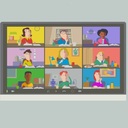Vortrag: Multimodal meaning-making in social distancing times: an analysis of the video conferencing tool 'Zoom' as a digital classroom

Several digital alternatives have been proposed for the teaching and learning of English as a foreign language (EFL) in the current scenario of social distancing. The video conferencing tool Zoom has particularly caught the eyes of educators for allowing synchronous communication in addition to providing tools that try to simulate resources found in the classroom. Based on theories of multimodality (Kress, 2010) and multiliteracy in digital media (Cope & Kalantzis, 2012), the authors of this work understand that the virtual and physical environments share similar opportunities for exploring modes. However, even if considered that the modes explored in each context (virtual and face-to-face) are the same and meaning-making can occur effectively, some features that are intrisic to the genre 'online class' can reflect badly on the interaction between the participants. In this sense, this work aims at analyzing the feasibility of Zoom to replace in person classes, taking into account the unique nature of teacher-student interaction in the classroom. Furthermore, it examines how the resources available on Zoom can be explored in teaching and learning contexts, and whether they effectively emulate and/or resignify how interaction and mediation are given in person. To analyze this, the authors examined and cataloged the tools currently available on Zoom and, thereafter, those that had the purpose of emulating practices that occur in the genre “class” (Costa, 2013; Marcuschi, 2008) were analyzed for their modes and possible correspondence with components present in the face-to-face interaction. The most current findings of this work show that Zoom allows educators to resignify - through the usage of specific resources - the need for a dynamic and interactive space within virtual education.
REFERENCES:
• BAKHTIN, M. Estética da criação verbal. São Paulo: Martins Fontes, 2000.
• COPE, B; KALANTZIS, M. Literacies. New York: Cambridge University Press, 2012.
• COSTA, M. A. M. C. Code-switching em salas de aula de língua inglesa. 2013. 128 f. Dissertação (Mestrado) - Curso de Linguística, Universidade Federal de Pernambuco, Recife, 2013.
• HYMES, D. Models of the Interaction of Language and Social Life. In:
GUMPERZ, J; HYMES, D. (Orgs.) Directions in Sociolinguistics: The Ethnography of Communication. Holt, Rinehart and Winston, Inc, 1972. p. 54 - 70.
• KRESS, G. Multimodality: a social semiotic approach to contemporary communication. New York: Routledge, 2010.
• MARCUSCHI, L. A. Gêneros textuais: definição e funcionalidade. In: DIONÍSIO, A. P.; MACHADO, A. R.; BEZERRA, M. A. (Orgs.). Gêneros textuais & ensino. Rio de Janeiro: Lucerna, 2002. p. 19-36.
• ZAVAM, Aurea. Transmutação: criação e inovação nos gêneros do discurso. Linguagem em (dis)curso, Tubarão, v.12, n.1, p.251-271, abr. 2012. Disponível em: https://www.scielo.br/pdf/ld/v12n1/v12n1a12.pdf. Acessed in: 05 set. 2020.
Info
Tag:
21.11.2020
Anfangszeit:
12:15
Dauer:
00:30
Raum:
Clotilde Tambroni
Track:
Applied Linguistics
Sprache:
en
Links:
Feedback
Uns interessiert Ihre Meinung! Wie fanden Sie diese Veranstaltung?
Gleichzeitige Events
ReferentInnen
 |
Camila Medeiros |
 |
Lucas Cruz |